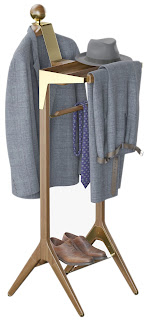Hats can be worn in all occasions, from everyday to fancy dress. The most popular are the top hat, bowler, homburg, trilby, beret, Breton, fedora, flat cap, and the Panama. Optimo Chicago and Lock & Co. Hatters of St.James's St., London are manufacturers and suppliers of many styles of hats. The Nines sell Panama hats. Hornskov are hat makers who still make hats by hand and even make custom hats.
Bowler
19th century, after either John Bowler, a London hat manufacturer from the 1820s to the 1840s, or William Bowler, hat-manufacturer, of Southwark Bridge Road, Surrey, who sought a patent for the hat in 1854.
Fedora
1887, American English, from "Fédora," a popular play by Victorien Sudan (1831-1908) that opened in 1882, in which the heroine, a Russian princess named Fédora Romanoff, wore a center-creased, soft brimmed hat. Women's-rights activists adopted the fashion. The proper name is the Russian feminine of Fedor, from Greek Theodoros, literally "gift of god," from theos "god' + dōron "gift".
Trilby
In 1897, named after Trilby O'Ferrall, eponymous heroine of the novel by George du Maurier published in 1894. In the stage version of the novel, the main character wore this type of soft felt hat.
Porkpie
19th century, named after its resemblance to actual pork pies that were commonly found in English bakeries.
Homburg
In 1894, from Homburg, a resort town in Prussia (now Germany), where it was first made.
Top Hat
In 1793, the first silk top hat in England is credited to George Dunnage, a hatter from Middlesex, England. According to fashion historians, gentlemen began to replace the tricorne hat with the top hat at the end of the 18th century. A painting by Charles Vernet of 1796, Un Incroyable, shows a French dandy with such a hat.
Beret
19th century, from French béret, from dialect of Béarn, from Old Gascon berret for "cap," from Medieval Latin birretum, a diminutive of Late Latin birrus meaning a "large hooded cloak," a word perhaps of Gaulish origin.
Flat Cap (Ivy)
Dating back to 14th century England where it was simply called a "flat cap", called an "ivy-cap" in the USA due to its popularity at Ivy League schools in New England. Also called a "driving cap" because of its popularity amongst taxi-cab drivers in New York and Boston.
Breton
19th century, originally worn by senior officers in the Russian and Prussian Armies, later adopted by the working class in northern Europe where it became popular for its protective and water repellent qualities, especially amongst fisherman in the Breton (Brittany) region of France.
Panama
Attested from 1833, ostensibly after the country Panama but the hat was originally made in Ecuador. "Panama" was the name of a settlement founded in 1519, from a Guarani word traditionally said to mean "place of many fish."
Casual Hats
My go-to casual hat is the finest made sailing hat in the world — the Tilley T3. Designed by Alex Tilley, an avid sailor, who could not find a high quality hat for sailing, so he designed his owned and started a company to produce them. They are now popular world wide. I have had two of the T3s in size 7 ⅜. The first one wore out after about 25 years and was replaced for free. My size is 7 3/8.

























